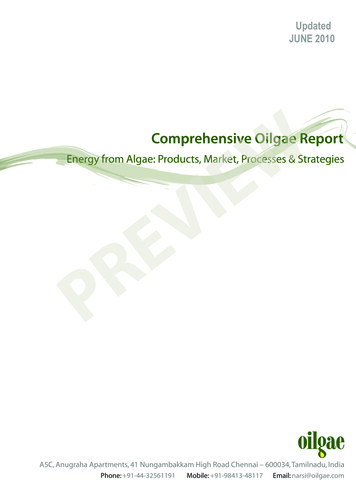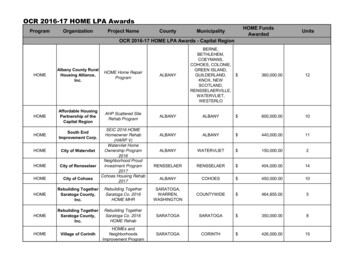
Transcription
UpdatedJUNE 2010WEComprehensive Oilgae ReportIVEnergy from Algae: Products, Market, Processes & StrategiesERPA5C, Anugraha Apartments, 41 Nungambakkam High Road Chennai – 600034, Tamilnadu, IndiaPhone: 91-44-32561191Mobile: 91-98413-48117Email: narsi@oilgae.com
Comprehensive Oilgae Report - PreviewThe Comprehensive Oilgae Report is a detailed report on all aspects of algaebiofuels. This preview provides inputs on focus areas of the report, the completelist of contents, and sample data from each chapter of the report.The report was prepared by Oilgae, the world’s leading business intelligenceresource on algae fuels.The Comprehensive Oilgae Report was last updated in the 3rd week of June 2010,and has 677 pages.Home of Algal Energywww.oilgae.com
Comprehensive Oilgae Report - PreviewList of ContentsConcepts & Cultivation Energy from Algae – IntroductionAlgal Strain SelectionAlgae CultivationPhotobioreactorsHarvestingEnergy Products from Algae Biodiesel from AlgaeHydrogen from AlgaeMethane from AlgaeEthanol from AlgaeOther Energy Products – Syngas, Hydrocarbon Fuels, Energy from Combustion ofAlgae BiomassAlgae Meal / CakeProcesses & Challenges Algae Grown in Open, Closed Ponds and PhotobioreactorAlgae Grown in Sewage & WastewaterAlgae Grown in DesertAlgae Grown in Marine Environment & Salt Water EnvironmentAlgae Grown in Fresh WaterAlgae Grown Next to Major CO2 Emitting IndustriesIndustry & Market Information Cost of Making Oil from AlgaeCompanies in the Algae to Energy IndustryIndustry Profile & Company StrategiesPotential for Existing Companies in RelatedFunding & Venture FundingNon‐Fuel Applications of AlgaeBiofuels in Real‐worldReference Apex Bodies, Organizations, Universities & ExpertsCulture Collection CentersFuture TrendsHome of Algal Energywww.oilgae.com
Comprehensive Oilgae Report - PreviewAn Invaluable Guide to the Algae Fuel IndustryBy providing a comprehensive collection of insights and data on all the criticalaspects of algae fuels, the Comprehensive Oilgae Report is an invaluable assetthat can shave many years of your team’s research efforts in this area.Algae fuels present an exciting opportunity. There is a strong view among industryprofessionals that algae represent the most optimal feedstock for biofuel production inthe long run. It is also widely accepted that algae alone – and no other bio‐feedstock ‐have the ability to replace the entire global fossil fuel requirements. Such a significantopportunity has resulted in companies both large and small investing in algal energy.Algae present multiple possibilities for fuel end‐products – biodiesel, ethanol, methane,jet fuel, biocrude and more – via a wide range of process routes. Each of these processroutes presents its own set of opportunities, parameters, dynamics and challenges.Efforts into algae fuel research have accelerated in the past few years. As of mid 2010,about hundred companies and over a hundred universities have begun seriousexploratory efforts into algae fuels.All these efforts will benefit enormously if a comprehensive resource is available thatbrings them up‐to‐date on the various critical aspects of the industry, status of past andon‐going efforts, and critical data for assessing the technical and economic feasibility ofalgae fuels. Such a comprehensive resource has the potential to save many months ofresearch and analysis.The Comprehensive Oilgae Report was developed to satisfy this clear need.The Comprehensive Oilgae Report is the most detailed report dealing with all aspects ofthe algae fuel industry. The report is divided into four main sections: Concepts and CultivationDiverse Energy Products from AlgaeProcesses & ChallengesIndustry & Market InformationHome of Algal Energywww.oilgae.com
Comprehensive Oilgae Report - PreviewEach section provides in‐depth information, details and updates on the most criticalaspects relevant to it.The objective of the Comprehensive Oilgae Report is to facilitate tangible steps for analgae fuel venture. The emphasis hence is on providing practical data, updates andinsights.In addition, the report has made special efforts in identifying the core challenges facedin each aspect of the algae fuels value chain. It also provides inputs on the currentefforts and possible solutions to overcome these challenges.The report has been developed with over two years of in‐depth research, and has beendeveloped with inputs from biofuel industry experts, biotechnology researchers, andprofessionals who have been constantly interacting with the algae fuels industry forover four years.The Comprehensive Oilgae Report will be an invaluable guide to those keen onventuring into one of the most exciting renewable energy domains.Home of Algal Energywww.oilgae.com
Comprehensive Oilgae Report - PreviewSpecial FocusThis report has a special focus on certain unique areas in algae energy which are knownto have huge commercial benefits. Owing to their in‐depth understanding of the algaefuels industry with its various aspects and dimensions, the team of researchers of Oilgaecontinuously make important research efforts into emerging topics in algae fuels, andhow businesses around the world can benefit from these topics.Some of the topics that are of emerging interest in the context of algae fuels areprovided below:Macro Vs Micro Algae Microalgae have high oil content but are difficult to cultivate and harvest in acost‐efficient manner.Macroalgae, on the other hand, present low‐cost cultivation and harvestingpossibilities, but most species are low in lipids as well as carbohydratesWith processes such as cellulosic fermentation (for deriving ethanol), gasification(for deriving biodiesel, ethanol and a wide range of hydrocarbons), or anaerobicdigestion (for methane or electricity generation), it is possible today to usemacroalgae as the feedstock for biofuels.Thus, both micro and macroalgae are potential feedstock for biofuels.Which of the two feedstocks should be used? Which of the processes is mosteconomical? The report provides insights on these critical aspects of algae biofuels.Waste Water Treatment Hundreds of billions of dollars are spent worldwide on wastewater treatment.The present waste water and sewage treatment methods can be significantlyimproved both in terms of costs and in terms of efficiency by the use ofbioremediation agents such as algae.Algae, quite well‐known as bioremediation agents, are especially good atremoving nutrients and toxins from waste and sewage water.Can this fact be used by tens of thousands of companies around the world tochoose‐effectively treat wastewater while at the same time produce biofuels?Home of Algal Energywww.oilgae.com
Comprehensive Oilgae Report - PreviewThe report discusses this possibility at length and provides case studies, insights andreferences for this important topic.Power Plant CO2 Capture Capture and sequestration of CO2 is one of the most critical challenges today forbusinesses and governments worldwide.Thousands of CO2 emitting power plants and industries worldwide face thiscostly challenge ‐ reduce your CO2 emissions or pay penalties.One ton algae require, for their growth, 1.8 tons of CO2; algae thus are largeabsorbers of CO2. Combine their affinity for CO2 with the fact that algae can growpractically anywhere, and we are presented with an exciting opportunity ‐ Whatif these CO2 emitting industries and power plants could use algae to absorb theCO2 and generate biofuels in return?This is precisely what companies and power plants around the world arebeginning to explore.The report provides details on the concept, suitable algae strains and a number of casestudies of companies already exploring algae as a medium for capturing CO2 andproducing biofuels.Other Emerging Products from Algae For decades, algae have been used to make a variety of products ‐ fromnutraceuticals, to pigments to organic fertilizers.Today, companies are able to produce many more products from algae. Some ofthese applications of algae (for example some high‐end specialty chemicals)could fetch very high margins for the company that produces the algae biomass.Is it then possible for algae fuel companies to synergistically produce both fuelsand non‐fuel products thereby increasing their profits and prospects?This report provides inputs on the range of non‐fuel products that can be produced fromalgae and other emerging applications and end‐uses.Variety of Fuels and Processes While biodiesel is the most obvious fuel that can be considered from algae(owing to the large oil content of microalgae), it is but one of the products thatare possible.Home of Algal Energywww.oilgae.com
Comprehensive Oilgae Report - Preview Others include ethanol, methane, hydrogen, biogasoline and the algal biomassitself which can be used as a feedstock of combustion.A variety of processes exist for producing these fuels starting with algal biomass.Some of these processes are suitable for oil‐rich microalgae, some for starch‐richmacroalgae, some for lignocellulosic algae and some others for left‐over algaeextracts.What are the processes and pathways for each of these feedstocks and for the differentend‐products? What are the costs and benefits of each of these products and processes?The report explains these critical aspects at length.Latest Efforts in Cost‐effective Photobioreactors Growing microalgae in photobioreactors results in high algae productivity, andconsequently results in higher oil yields for the same area.However, photobioreactors are much more expensive than open ponds.Realizing the importance of lower cost photobioreactors, a number of companiesand research teams have started working on a variety of innovative designs andconcepts.What are the statuses of these current efforts in photobioreactor designs that can leadto lower‐cost and high‐productivity photobioreactors? Which are the companies that areleading the efforts in this domain? What are the likely future trends in photobioreactors?The report provides inputs and details for these questions.Home of Algal Energywww.oilgae.com
Comprehensive Oilgae Report - PreviewChapterwise List of Contents and Sample DataWhile interest in algae fuels has accelerated significantly in the recent past, contraryto popular belief, research into algae as a biofuel feedstock is not new – it is overthree decades old! Similarly, biodiesel is not the only fuel that can be derived fromalgae. This chapter provides an overview of algae, the history and current status ofalgae‐based fuels, and inputs on the range of fuel products that can be derived fromalgae.CHAPTER 1Energy from AlgaeIntroduction1.1 Algae1.2 Energy from Algae1.3 History & Current Status of Energy from Algae1.4 Algae Energy & Alternative Energy1.5 Big Challenges & Big Payoffs1.6 Energy “Products” from Algae1.7 Determining the Optimal “Energy Product”1.8 Algae to Energy – Summary of Processes for Each Energy Product1.9 Trends & Future of Energy from Algae1.10 FactoidsSAMPLE TOPICEnergy “Products” from AlgaeAlgae to Energy – Summary of Processes for Each Energy ProductFinal ProductProcessesBiodieselOil extraction and obic digestion of biomass; Methanation of syngas producedfrom biomassHydrogenTriggering biochemical processes in algae; Gasification / pyrolysis ofbiomass and processing of resulting syngas.Heat & ElectricityDirect combustion of algal biomass; Gasification of biomassOther Hydrocarbon FuelsGasification/pyrolysis of biomass and processing of resulting syngasHome of Algal Energywww.oilgae.com
Comprehensive Oilgae Report - PreviewDetailed descriptions on above processes, key advantages, companies,challenges & efforts, research and case studies have been provided foreach of the above productsPaths to the Various Energy Products from AlgaeExtractionAlgal BiomassFermentationGasificationAnaerobic isFermentationIGCC/IC/Fuel ustion / Gasification /pyrolysisAlgal OilFischer ficationDetailed description of each and every process is provided in various chapters.Home of Algal Energywww.oilgae.com
Comprehensive Oilgae Report - PreviewCHAPTER 2Algal Strain SelectionSelection of the optimal algal strain is a key component of a successful algal biofuelventure. With tens of thousands of possible strains to choose from, this is howevereasier said than done. A number of parameters need to be kept in mind whileevaluating algal strains for their suitability as biofuel feedstock. This chapterprovides comprehensive details on the parameters to be used for strain selectionand also the list of strains that are high in oil (for biodiesel) and in starch (forethanol).2.1 Importance of Algal Strain Selection2.2 Parameters for Strain Selection2.3 Strains with High Oil Content & Suitable for Mass Production2.4 Strains with High Carbohydrate Content2.5 Strains – Factoids2.6 Challenges & EffortsSAMPLE TOPICStrains with High Oil Content & Suitable for Mass ProductionBotryococcus brauniiA green alga, Botryococcus comes up repeatedly in nearly every forum, initiative andgeneral information web site about the potential to create biodiesel from algae. This strainspecifically can produce hydrocarbons which represent 86% of its dry weight Ambient temperature of 23 degrees Celsius (73.4 degrees F) A light intensity of 30‐60 W/m2 A photoperiod of 12 hours light and 12 hours dark Salinity of 8.8% (brackish waters)With these conditions satisfied, strain cells doubled approximately every two days.Oil content range: 25‐75%We have provided similar data for over 15 most optimal strains. We havealso provided optimal algal strains for different cultivation conditions suchas fresh water, salt water, sewage‐based & desert‐based cultivation.Home of Algal Energywww.oilgae.com
Comprehensive Oilgae Report - PreviewCHAPTER 3Algae CultivationCost‐effective algal cultivation is a key requisite for success algal biofuel production.However, such cultivation of the right strain of algae, especially microalgae, in theright environment and media is a key challenge facing algae fuel companies. Thischapter provides in‐depth details on the various forms of algaculture and keysuccess factors for the same. The chapter has a special focus on the criticalchallenges in algaculture for biofuels and the latest efforts and proposed solutionsto overcome these challenges.3.1 Introduction & Concepts3.2 Algaculture Algae Monoculture Photosynthetic Cultures Mixotrophic Cultivation of Microalgae Batch Culture Semi‐continuous Culture Factors that Determine Algal Growth Rate3.3 Algae Cultivation in Various Scales3.3.1 Algae Cultivation in Lab‐scale3.3.1.1 Isolation of Algae3.3.1.2 Cultivation in Lab Scale3.3.1.3 Biochemical Analysis of Algal Samples3.3.2 Algae cultivation in commercial scale3.3.2.1 Ponds3.3.2.2 Photobioreactors3.4 Different Methods of Cultivation3.5 Algae Cultivation –Factoids3.6 Worldwide Locations with Algae Farms & Algae Cultivation3.7 Algae Cultivation Challenges Challenges in Cultivation Challenge of Growth Rate of Algae Challenge of Formulation of Medium Provision of CO2 Water Circulation in Ponds Photosynthesis or Fermentation Land Requirements Scaling Up Challenges Other challenges in algae cultivation for which there is ongoing research3.8 Research & Publications3.9 ReferenceHome of Algal Energywww.oilgae.com
Comprehensive Oilgae Report - PreviewSAMPLE TOPICBest Method to Grow Algae – Ponds or Photobioreactors?Which is the best way to grow algae ‐ Ponds or Photobioreactors?The NREL (National Renewable Energy Laboratory, USA) favoured unlined “raceway”ponds which were stirred using a paddle wheel, and had carbon dioxide bubbled throughit. The water used for these ponds is wastewater (treated sewerage) freshwater, brackishwater, or salt water, depending on the strain of algae grown. The algae should be a nativeto the region. Other countries, notably Japan, are interested in closed systems; howeverthese systems (at least from NREL perspective) are very expensive.Inputs are provided on the various distinctions between ponds andphotobioreactors, list of companies that are using either of these & a list ofworldwide locations of algae farms / photobioreactors.Culture Methods Followed for Different Algal SpeciesBotryococcus brauniiMedium: Chu 13 medium (for hydrocarbon production BG11 medium)Procedure: Modified Chu 13 medium is cultured.Purification is done by serial dilution followed by plating.The individual colonies are isolated and inoculated into liquid medium (modifiedChu 13 medium)It can be incubated at 25 1oC under 1.2 0.2 Klux light intensity with 16:8 hrslight photoperiod.The purity of the culture is ensured by repeated plating and by regularobservation under microscope.Home of Algal Energywww.oilgae.com
Comprehensive Oilgae Report - PreviewCulture environment: B. braunii grows best at a temperature of 23 C, a light intensity of60 W/M², with a light period of 12 hours per day, and a salinity of 0.15 Molar NaCl.Challenges and efforts: B. braunii is found to be able to co‐exist with a wild green alga,Chlorella sp.; the presence of either alga did not negatively affect growth of the other.They form colonies/flocs which are difficult to break down. It grows very slowly: it’sdoubling time is 72 hours (Sheehan et al., 1998), and two days under laboratoryconditions (Qin, 2005).We have provided similar data for over 10 most optimal strains. We havealso provided various cultivation methods of algae in laboratory andcommercial scale.Home of Algal Energywww.oilgae.com
Comprehensive Oilgae Report - PreviewCHAPTER 4PhotobioreactorsPhotobioreactors (PBR) enhance the technical feasibility of producing fuels fromalgae by providing an optimal controlled environment that result in higher algalproductivity while preventing contamination by hostile species. At the same time,PBRs are much more expensive than open ponds, thus currently hindering theeconomic feasibility of biofuel production. How is the industry responding to theopportunities and challenges presented by the PBRs? This chapter provides insightsand inputs that will enable a useful analysis of these questions.4.1 Concepts4.2 Types of Bioreactors Used for Algae Cultivation Tubular photobioreactors Flat‐plate photobioreactors Air‐lift bioreactor4.3 Parts & Components4.4 Design Principles4.5 Costs4.6 PBR Manufacturers & Suppliers4.7 Photobioreactors – Q&A4.8 Research Done on Bioreactors and Photobioreactors4.9 Challenges & Efforts in Photobioreactor4.10 Useful ResourcesSAMPLE TOPICCostsFor successful outdoor mass algae cultivation, photobioreactors should possess thefollowing characteristics / properties: High surface‐to‐volume ratioHigh mass transfer rateHigh surface illuminationHigh Cost of PhotobioreactorsPhotobioreactors represent perhaps the highest cost item in algae cultivation.Photobioreactors are expensive owing to their sophistication. Currently (as of Oct 2008),Photobioreactor costs range between 60‐100/ m2, though there some up and comingcompanies that claim to provide these at much lower capital costs.Home of Algal Energywww.oilgae.com
Comprehensive Oilgae Report - PreviewThis chapter talks in detail about photobioreactor, its types, parts andcomponents, designs etc. Some sample data based on publicly availableprices and costs for photobioreactors from commercial companies are alsoprovided.Q&AData, answers and insights are provided for the following questions What is the comparative production capacity of PBR & pond alternative, for similararea used?How often should the PBR be cleaned?What are the major parts of a PBR, and what are the parts that make it costly?What are closed loop photobioreactors?For what algae‐based products are photobioreactors predominantly used?For what kinds of products is the use of photobioreactor economical?When is the use of photobioreactors mandatory for algae cultivation?How costly are photobioreactors when compared to open ponds?What are the primary cost components in photobioreactor systems?Is it possible to eliminate photobioreactor components without affecting the algaegrowth process?Why is it essential to pump air and CO2 together into the photobioreactor?Home of Algal Energywww.oilgae.com
Comprehensive Oilgae Report - PreviewCHAPTER 5HarvestingHarvesting, especially for microalgae, represents an important cost component,owing to the difficulties involved in the processes. It is hence important for thoseexploring the algae fuels industry to gain a clear understanding of the variousharvesting options available, the challenges in each of the options, and the currentefforts and solutions being attempted to overcome these challenges. This chapterprovides inputs on all these, as well as relevant case studies that provide the readerinsights on the worldwide real‐life harvesting practices.5.1 Introduction5.2 Methods of Harvesting Filtration Sedimentation Centrifugation Flocculation Flotation Other Methods5.3 Case Studies & Examples5.4 Trends & Latest in Harvesting Methods5.5 Challenges & EffortsSAMPLE TOPICMethods of HarvestingHarvesting MicroalgaeThe ease in harvesting the algae depends primarily on the organism's size, which determineshow easily the species can be settled and filtered. The most rapidly growing algal species arethe microalgae, very small, and often motile unicells, and these are the most difficult toharvest. Thus, it is necessary to maintain an effective interaction between the development ofharvesting technologies and the selection of algal species for mass culture.The main harvesting methods for microalgae are: Settling & Sedimentation Filtration & Related ‐ Mechanical harvesting using filtration, by means of strongmembranes, such as microscreens, and using microstrainers. Chemical Methods ‐ Chemical and/or biological harvesting by means offlocculants Centrifugation ‐ Algae can also be harvested using centrifugationHome of Algal Energywww.oilgae.com
Comprehensive Oilgae Report - Preview Flotation ‐ Froth flotation is a method whereby the water and algae are aeratedinto froth, with the algae then removed from the water.Detailed inputs are provided for each of the above methods, withexamples of companies using each and challenges faced in harvestingprocess. Other related methods such as polymer harvesting, ultrasound‐based & vibrating separation are also discussed.Home of Algal Energywww.oilgae.com
Comprehensive Oilgae Report - PreviewCHAPTER 6Biodiesel from AlgaeProducing biodiesel from algae provides the highest net energy because convertingoil into biodiesel is much less energy‐intensive than methods for conversion to otherfuels (such as ethanol, methane etc). This characteristic has made biodiesel thefavourite end‐product from algae. Producing biodiesel from algae requires selectinghigh‐oil content strains, and devising cost effective methods of harvesting, oilextraction and conversion of oil to biodiesel. This chapter provides comprehensivedetails on the methods for and latest trends in oil extraction and conversion tobiodiesel.6.1 Introduction to Biodiesel6.2 Growth of Biodiesel6.3 Biodiesel from Algae6.4 Why Isn’t Algal Biodiesel Currently Produced on a Large‐scale?6.5 Oil Yields from Algae6.6 Methods to Extract Oil from Algae Current Methods of Oil Extraction Expeller/Press Chemical Solvents Hexane Solvent Method Supercritical Fluid Extraction Other Less Well‐known Extraction Methods Algae Oil Extraction – Trends & Developments Advances in Oil Expellers Oil Extraction – Efforts & Solutions Challenges6.7 Converting Algae Oil into BiodieselHome of Algal Energywww.oilgae.com
Comprehensive Oilgae Report - PreviewSAMPLE TOPICBiodiesel from AlgaeThis section elaborates on the advantages of algae fuels, problems andbottlenecks in each step of the algae to energy processes, case studies &research. Similar process details are given for the production of hydrogen,methane, ethanol and syngas from algae.Increasing the Oil Yields from AlgaeA Summary of Comparison of Oil and Biodiesel Yield from Main Energy CropsOil SourceSoyBiomass (Mt/ha/yr)1‐2.5Rapeseed3Palm Oil19Jatropha7.5‐10Microalgae14‐255Note: Mt – metric tons, ha – hectareHome of Algal Energywww.oilgae.com
Comprehensive Oilgae Report - PreviewYields from algae are much higher than those from other oil crops andthere is a huge potential to increase this high yield even further. Thischapter will discuss these important aspects and explains to what extentyields have been achieved in real‐life.Challenges in Extraction of Oil from AlgaeDetermining the most efficient and cost effective extraction methodThe challenge here is that higher the efficiency of the extraction method, the higher isits cost. Please refer to the details provided under the “Algae Oil Extraction – Trends &Developments” for inputs on various ongoing efforts to overcome these challenges.Reducing the energy requirements for extractionAlgae oil extraction is quite energy intensive and this is an important challenge to berecognized and addressed. EffortsOriginOil’s invention of a method to extract the oil from algae with highenergy efficiency that builds on the company’s first patent, Quantum Fracturing , inwhich ultrasound from intense fluid fracturing breaks down algae cells and reduces theoverall energy required for extraction.Detailed inputs are provided for challenges in each and every step inbiodiesel production, and efforts made to overcome them. Similar contentare given for all the energy products that can be derived from algae.Home of Algal Energywww.oilgae.com
Comprehensive Oilgae Report - PreviewCHAPTER 7Hydrogen from AlgaeHydrogen is technically not a source of energy, but is a carrier of energy. Hydrogen isexpected to play a major role in the future of renewable and clean energy, primarilywith its potential for application in fuel cells. Hydrogen production from algae is inthe research stages, but holds significant potential for the future. This chapterprovides details on the scientific foundation for hydrogen production from algae andthe latest research efforts worldwide.7.1 Introduction7.2 Methodologies for Producing Hydrogen from Algae7.2.1 Biochemical Processes7.2.2 Hydrogen Production through Gasification of Algae Biomass7.3 Factoids7.4 Current Methods of Hydrogen Production7.5 Current & Future Uses of Hydrogen7.6 Why Hasn’t The Hydrogen Economy Bloomed?SAMPLE TOPICMethodologies for Producing Hydrogen from AlgaeBiochemical Processes ‐ Under specific conditions, algae produce hydrogen, viabiological and photobiological processes. Under these conditions, enzymes in the cellact as catalysts to split the water molecules. More details on this are provided in latersections of this chapter.Gasification – Gasifying biomass gives syngas, a mixture of CO and H2. A number ofmethods are being researched to separate the H2 from syngas.Through Steam Reformation of Methane – Fermentation of algal biomass producesmethane. The traditional steam reformation (SMR) techniques can be used to derivehydrogen from methane.Detailed inputs & recent research updates are provided for each of theabove methods. In addition, details of hydrogen production usingtraditional methods are also given. This chapter focuses on efforts to usealgae to produce hydrogen.Home of Algal Energywww.oilgae.com
Comprehensive Oilgae Report - PreviewMethane production from algae could be a viable route especially where thefeedstock is algae cake (the biomass left‐over after oil is extracted from algae). Thepossibility of methane being easily integrated with the current uses of natural gasenhances its attractiveness as a fuel. For this reason, there are a number of researchand pilot efforts worldwide exploring methane production from algae. This chapterprovides details on the latest efforts in this direction.CHAPTER 8Methane from Algae8.1 Introduction8.2 Methods of Producing Methane from Algae8.3 Methane from Algae – Other Research & Factoids8.4 Traditional Methods of Methane Production8.5 Methane – Current & Future Uses8.6 What’s New in Methane?SAMPLE TOPICMethods of Producing Methane from genesisAcetateH2MethanogenesisCH4Home of Algal Energywww.oilgae.com
Comprehensive Oilgae Report - PreviewIn this chapter, methods of producing methane through anaerobicdigestion and pyrolysis are explained in detail. In addition, references areprovided for current and on‐going research efforts for producing methaneusing algal biomass.Home of Algal Energywww.oilgae.com
Comprehensive Oilgae Report - PreviewCHAPTER 9Ethanol from AlgaeWhile the initial efforts to produce biofuels from algae focused on biodiesel as theend product, many of the later efforts also have started exploring the production ofethanol from algae. The significant investments made into ethanol production andthe consequent technological innovations could make ethanol production fromstarch and cellulose‐rich algae a viable alternative. This chapter provides detailedinputs on the various processes and routes for ethanol production from algae, andcase studies and updates on the latest ventures in this domain.9.1 Introduction9.2 Ethanol from Algae ‐ Concepts & Methodologies Fermentation of algae biomass Fermentation of algae extract left over after extraction of oil Fermentation of syngas9.3 Efforts & Examples for Ethanol from Algae9.4 Examples of Companies in Algae to Ethanol9.5 Algae & Cellulosic Ethanol9.6 Current Methods of Ethanol Production9.7 Ethanol –Latest Technology & MethodsSAMPLE TOPICEfforts & Examples for Ethanol from AlgaeEthanol from MacroalgaeAn exploration for producing ethano
three decades old! Similarly, biodiesel is not the only fuel that can be derived from algae. This chapter provides an overview of algae, the history and current status of algae‐based fuels, and inputs on the range of fuel products that can be derived from algae. 1.1 Algae 1.2 Energy from Algae










